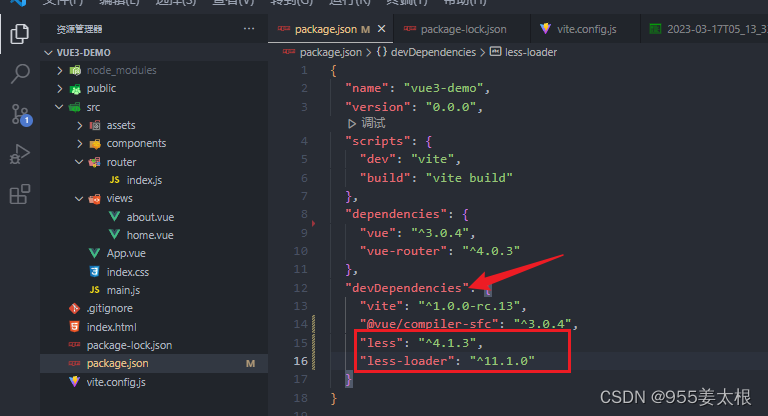一.使用vite搭建vue3项目:
1.安装vite前端构架工具---比脚手架cli更快捷
npm install -g create-vite-app2.创建一个项目名称为
vue3-DOME的项目:create-vite-app vue3-demo省略第1步和第2步骤直接创建可选择是否使用路由,tapescript等:
npm init vue@latest3.安装node-modous然后运行
cnpm install4.vite.config.js配置:(vite创建的项目需要在根目录创建一个vite.config.js文件进行项目配置,和vue2版本的vue.config.js文件类似)---我的理解是替换webpack打包
import {resolve} from 'path' module.exports = { alias: { //配置别名 '/@/': resolve(__dirname, './src') }, hostname: 'localhost', // 默认是 localhost port: '8000', // 默认是 3000 端口 open: false, // 浏览器自动打开 https: false, // 是否开启 https ssr: false, // 服务端渲染 base: './', // 生产环境下的公共路径 outDir: 'dist', // 打包构建输出路径,默认 dist ,如果路径存在,构建之前会被删除 proxy: { // 本地开发环境通过代理实现跨域,生产环境使用 nginx 转发 '/api': { target: 'http://127.0.0.1:7001', // 后端服务实际地址 changeOrigin: true, rewrite: path => path.replace(/^\/api/, '') } } }
二.使用路由vue-router
1.安装router
npm install vue-router@4.0.32.安装完成后,在src文件夹下创建router文件夹,router文件夹创建index.js文件,并在src下面创建views文件夹下创建自己的页面以及内容
import { createRouter, createWebHistory } from 'vue-router' // 开启历史模式 // vue2中使用 mode: history 实现 const routerHistory = createWebHistory(); const router = createRouter({ history: routerHistory, routes: [ { path: '/', redirect: '/home' }, { path: '/home', component: () => import('../views/home.vue') }, { path: '/about', component: () => import('../views/about.vue') } ] }) export default router3.在main.js里面引入注册
import { createApp } from 'vue' import App from './App.vue' import router from './router' //引入router import './index.css' const app = createApp(App) app.use(router) app.mount('#app') //注意注册app实例要放在最后一行4.在App.vue使用<router-view></router-view>
<template> <!-- 使用router --> <router-view></router-view> </template> <script> export default { name: 'App', components: { } } </script>
三.vue3使用css预处理器less
1.安装less以及less-loader
npm install less less-loader --save2.注意:less 和 less-loader 需要写到 package.json 文件中的 devDependencies 里面,否则项目运行会报错。
1
1
四.vue3使用axios和后端数据交互(和vue2相同)
1.安装axios
npm install axios2.二次封装axios请求request.js,在src下创建utils文件夹里面创建request.js里面的代码如下:
3.在src下创建api文件夹里面创建一个api.js
4.在.vue中使用
五.vue3使用fetch和后端数据交互
1.安装fetch
2.
二.vue3和vue2的区别(proxy,segment,api,hooks,slot,emit)
1.
template中可以有多个根节点:,vue2只能有一个根节点2.vue3也是使用axios,vuex,吗?
axios | fetch, pinia | vuex41
1
1
1
1
1
1
1
1
vue3响应式返回代理对象的是proxy不是对象{ },只有代理对象才是响应式的
vue3使用组件:
1.vue3使用组件只需引入不需要注册
<template> <div> <topBar></topBar> </div> </template> <script setup> import { ref } from 'vue' import topBar from '../../components/topBar.vue'; </script> <style scoped> </style>2.父传子参数(在子组件中用 defineProps 宏 来声明)
- 在父组件中定义并传值(用于单组件引用--只引用一个组件)
<template> <div> <topBar :topList="topRef.topList"></topBar> </div> </template> <script setup> import { ref } from 'vue' import topBar from '../../components/topBar.vue'; const topRef = ref({ topList:[ {name:'flex布局'},{name:'全局api'} ] }) </script> <style scoped> </style>
- 多组件引用
- 在子组件中接收:
<template> <div class="content"> <div v-for="(item,index) in topList" :key="index">{{ item.name }}</div> </div> </template> <script setup> import { ref } from 'vue' defineProps(['topList']) </script> <style scoped> .content{ width: 100%; display: flex; flex-direction: column; } </style>




 本文介绍了如何使用vite搭建Vue3项目,包括vite.config.js配置、vue-router的安装与应用、less预处理器的安装及注意事项,以及axios在Vue3中的使用。同时,对比了Vue3与Vue2在组件、响应式系统等方面的不同。
本文介绍了如何使用vite搭建Vue3项目,包括vite.config.js配置、vue-router的安装与应用、less预处理器的安装及注意事项,以及axios在Vue3中的使用。同时,对比了Vue3与Vue2在组件、响应式系统等方面的不同。

















 2000
2000










